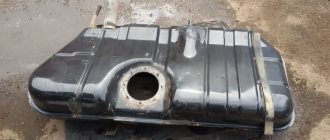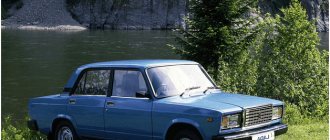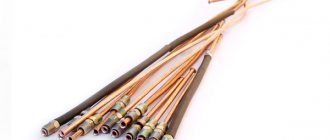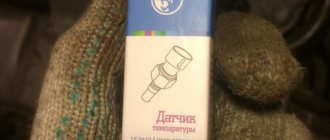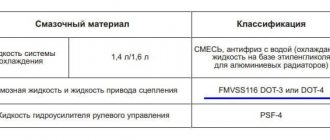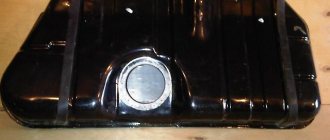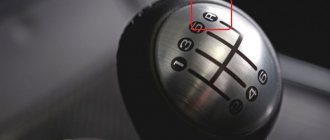WHAT BRAKE FLUID TO FILL IN A VAZ 2114
The VAZ 2114 car is equipped with a brake system with a hydraulic drive. A special feature of the vehicle on this machine is the diagonal distribution of the brake circuits. If one of them fails, the second provides braking with high efficiency. The working substance for vehicles is brake fluid VAZ 2114 “Rosa”, “Rosa-3”, “Rosa-DOT-4”.
Design
The task of the driver and car owner part-time is to constantly monitor the condition of the brake system.
Failure of one of its elements can lead to serious consequences. Therefore, you should know what exactly is included in the braking system.
- Brake fluid reservoir mounted on the GTZ;
- Metal pipelines of two circuits;
- Flexible brake hoses for front and rear wheels;
- GTZ ( brake cylinder located in the engine compartment);
- Brake cylinders of front and rear wheels;
- Pressure regulator;
- Brake fluid level sensor;
- Vacuum booster.
Tank with TJ
According to the recommendations of specialists, the replacement of the TZ is carried out once every 3 years, but at least once every 45 thousand kilometers.
Vehicle malfunctions leading to replacement of the vehicle with a VAZ 2114
The hydraulic brake system includes many different parts that allow you to operate the brakes using hydraulic fluid. It includes:
- a tank that is attached to the gas turbine engine and is intended for filling the fuel fluid;
- metal pipelines of both circuits;
- flexible brake hoses of front and rear wheels;
- GTZ installed in the engine compartment;
- working brake cylinders of front and rear wheels;
- dual-circuit pressure regulator;
- a sensor showing at what level the fuel fluid is located;
- a vacuum booster, the task of which is to create working fluid pressure in the pipelines of the circuits in order to ensure effective operation of the brake systems on the wheels during braking.
A car’s vehicle is one of the main systems that ensures the safety of the driver and passengers of the car, therefore regular preventive inspection of all elements of the vehicle is mandatory for the owner of the car.
The brake fluid on the VAZ 2114, according to the recommendations of technical specialists, is replaced every three years or no more than after 45 thousand kilometers of the vehicle.
At the same time, during the operation of a vehicle, malfunctions periodically occur in its braking system and especially in the hydraulic drive, leading to the need to replace the brake fluid. Knowledge of these malfunctions and the reasons leading to them can help the driver avoid serious troubles on the road, since in this case he can promptly identify the failure and take measures to eliminate it.
Malfunctions in the vehicle resulting in the need to replace the vehicle:
- Leaks from the working brake cylinders leading to significant loss of fuel fluid.
- The formation of air pockets in main pipelines and flexible hoses, which are formed as a result of leaks in vehicle units.
- Rupture or fraying in the flexible hoses on the wheels, in this case the brake hoses on the VAZ 2114 need to be replaced. Damage to metal pipelines is also possible; as a rule, a leak forms due to “chasing”. In both cases, the liquid quickly flows out of the vehicle, so at the slightest sign of disorder in the vehicle, these parts should be checked first.
- Damage or swelling of the sealing rings in the GTZ or wheel cylinders. This also leads to leaks.
- Leakage of fuel fluid through the sealing rings of the rear wheel RD pusher.
- There may be a leak in one of the brake circuits. In this case, partial failure of the brake pedal occurs.
- Quite rarely, but metal pipelines become clogged.
- As a result of mechanical damage, failures of the GTZ, RTC, vacuum unit and other vehicle elements are possible. To eliminate these damages on the VAZ 2114, replacing the brake fluid is a prerequisite.
Filling brake fluid in VAZ 2115
Preparing for surgery
So, put the car in a pit or on a flat surface, then open the hood and remove the connector for the brake fluid level sensor. Then unscrew the cap and add liquid to the maximum level. After this, screw on the lid.
Please note: if you use a lift during the work, when bleeding the rear brakes you need to place the slot in the brake force regulator (also called the “sorcerer”). To do this, you can use a screwdriver by placing it between the rod and the bracket.
When bleeding the front brakes, this slot must be removed.
How to bleed the brakes on a VAZ- 2115 ? During the work we will need one assistant. He will press the brake pedal on command.
Selecting brake fluid and the procedure for replacing it on a VAZ 2114
For the normal functioning of the vehicle’s vehicle with maximum efficiency, it is important for the car owner to correctly select the working fluid for the hydraulic brake drive. Modern TG, such as “Rosa” and its varieties, are based on polyglycols and this accounts for from 93 to 98 percent of the total composition. The rest is various additives that are necessary to combat oxidation of fuel fluid and prevent corrosion of metal parts of the vehicle.
When purchasing a vehicle, you need to pay attention to the following parameters:
- boiling point, it should be high to reduce the likelihood of plug formation from steam bubbles;
- good viscosity, which characterizes the ability to pump liquid in the system;
- the ability to absorb water, that is, hygroscopicity;
- ability to lubricate internal surfaces;
- neutrality in relation to rubber parts of the braking system;
- oxidation resistance and corrosion resistance.
According to the TZh class for the VAZ 2114, they are marked DOT 3.
How to change the brake fluid on a VAZ 2114 - for the correct actions you need to carefully study the car’s operating manual.
Before starting work, you need to prepare the necessary tools and materials:
- TJ in the amount of 0.5 liters;
- keys and screwdrivers;
- transparent flexible hose;
- container for draining spent fuel oil;
- rags to wipe surfaces, especially plastic and painted ones, since the liquid is toxic and aggressive to these surfaces.
Required tools and materials
To get to the fittings in the absence of an inspection hole, we need to unscrew the wheels. Therefore, you need a jack, stops and a wheel wrench. If there is a hole or overpass, the wheels do not need to be unscrewed. fluid will also come in handy . On vehicles of the Samara-2 family, RosDot of the fourth class is used. In addition, we need a plastic bottle and a hose that will be put on the fitting (so that the liquid does not splash in different directions, but goes out into a certain container). To unscrew the fitting, you need a regular 8mm wrench.
How much brake fluid do you need to change?
Maintaining the required level of brake fluid is necessary for the proper operation of the vehicle's braking system. How much is needed can always be found in the service book, but often car owners are not used to looking into it, but act empirically or look for the answer on the Internet. It is these users that we will try to help figure out the question of how much brake fluid is needed for replacement and which one should be poured.
Brake fluid is the working fluid of the brake system, with its help the force created in the master cylinder is transmitted to the wheel pairs.
If the brake fluid level is below the minimum mark (by the way, this will be indicated by the corresponding icon on the instrument panel - a red circle with waves inside), then you need to top it up. It also doesn’t hurt to check the master brake cylinder and the brake system as a whole, since a decrease in the fluid level may indicate a malfunction or wear of the master cylinder gaskets. As a rule, the brake system of a passenger car contains from 0.55 to 1.0 liters of brake fluid. And its specification can very often be indicated on the body of the expansion barrel or its cover.
When checking, do not forget to pay attention to the color of the liquid . The new TJ is transparent with a yellowish tint. During operation, it changes its color and becomes dark, this is mainly due to the accumulation of various impurities. If the fluid has darkened, this may mean that a complete replacement is necessary and simple topping up is not enough. Experts recommend replacing brake fluid approximately every 2-3 years , this is the optimal interval in accordance with hygroscopicity and exposure to temperature loads. For the brake mechanisms to function properly, the fluid must have a number of properties and also meet a certain standard.
Reasons for replacement
There are several characteristic malfunctions that must necessarily entail the replacement of the TJ.
- The presence of leaks from the brake cylinders, which lead to the loss of a large amount of fluid.
- The appearance of air pockets in the pipeline and hose system. They arise due to a leak in the brake system elements.
- Scuffs or deformation of flexible hoses installed on wheels. They also require replacement of the hoses themselves.
- Violation of the integrity of the sealing rings in the main brake cylinder, which leads to leakage of the working substance.
- Fluid leaking through the sealing ring of the pusher on the rear wheels.
- Violation of the tightness of the system circuit. This can be felt by a partially collapsed brake pedal.
- Mechanical failure of one of the elements of the braking system. In addition to repairing or replacing them, you will definitely have to change the TZ.
READ Replacing the outer CV joint boot of a VAZ 2109
To choose the best option for a brake substance, you should take into account the main parameters of its selection so that it meets the requirements of the VAZ 2114 model. After all, this is the car we are talking about.
It must be high so that steam bubbles do not form inside the system and block the flow of liquid
Good viscosity ensures efficient pumping of fluid through the system
This criterion is responsible for the ability of a substance to absorb water
The thermal fluid should not only promote braking, but also prevent overheating of the internal surfaces due to the lubricating effect
The composition should not have a destructive effect on the rubber elements used in the system
The liquid should protect metal elements from corrosion and rust.
Having chosen the vehicle that is suitable for your car, you should replace it. It’s entirely possible to do the work yourself, but you should first read the instruction manual, consult with specialists, or watch visual video lessons.
Replacing and bleeding brake fluid using the example of a VAZ 21099. How to bleed the brakes yourself.
Draining and bleeding process
To replace the TJ yourself, you will need a certain set of tools and materials. This set includes:
- Brake fluid - 500 millimeters;
- A set of keys;
- Screwdriver Set;
- Transparent flexible hose;
- Container for draining old fluid;
- Dry rags for cleaning surfaces.
To work, you will definitely need the help of one more person, so when pumping, one should be inside the car, and the other outside.
- Unscrew the cap on the master cylinder reservoir and place it on a prepared surface. The cover is combined with the float of the fuel oil level sensor, so be careful, because a toxic and dangerous substance will remain on it.
- Unlock the rear brakes using a screwdriver. It is simply inserted between the plate and the piston. Ready.
Inserted a screwdriver
Replacing brake fluid yourself
- Clean the right rear brake release valve of any accumulated dirt and dust, then remove the rubber cap that covers the valve.
- Place a flexible transparent hose onto the valve fitting and place its other end in a container to drain the liquid.
- Approximately once every two seconds, press the gas pedal all the way four times in succession. When you press the fifth time, lock the pedal in the clamped position.
- Unscrew the valve at least half a turn. As the brake fluid drains, the pedal will gradually begin to sink.
- As soon as the fluid flow stops, close the valve.
- Simultaneously with the procedure, do not forget to monitor the level of fuel fluid in the tank.
- As you pump out the old substance, add a little new one. This will avoid the formation of air locks inside the system.
- Add fresh fuel fluid into the tank until all the old fluid comes out and new clean substance begins to flow through the hose into the container.
- Having completed the work on the rear right wheel, go to the front left and perform a similar procedure. Due to this movement pattern, you will be able to completely get rid of the old fuel oil in one circuit.
- By analogy, remove the fuel fluid from the second circuit in the same sequence. Having completed draining, close the valves with caps and add new fuel fluid to the required level.
Accuracy comes first
After completing the replacement procedure, be sure to bleed the brakes. It is strictly not recommended to go out on the road without it, since the brakes may simply not work.
Types and properties of fuel fluid
Old and new brake fluid
Any brake fluid has 93-98% of the main composition and from 2 to 7% of additives, which, in fact, are the key component for imparting the declared characteristics.
In general, if you look at it this way, the properties of brake fluid depend on the combination of its components. Depending on the composition of the base, TJ is divided into 3 groups.
Types of brake fluids:
- Mineral (mineral oil LHM) . They consist of alcohol and castor oil.
- Glycolic . Developed on the basis of polyglycols and their esters.
- Silicone . Manufactured from silicon-organic polymer products.
Regardless of the type and composition, all brake fluids are divided into two classifications.
Classification of TJ:
- By viscosity.
- By boiling point:
- for “dry” liquid (without water);
- “wet”, which contains 3.5% water.
If the boiling point exceeds the permissible norm, then there is a risk of a vapor lock forming in the system (as a result of moisture evaporation), which can lead to breakdown and failure of the brake pedal.
Brake fluid standards
In practice, and in most cases, it is customary to use the American quality standard FMVSS No. 116 (Federal Motor Vehicle Safety Standard), which was developed by the US Department of Transportation (DOT for short). So, often, in modern cars, either DOT 4 is used on a glycol basis, or DOT 5.1 (including glycol and silicone compounds). But in cars manufactured more than 20 years ago, BSK or DOT 3 fluid can be used.
Volume of fluid in the brake system
Basically, the brake system holds from 0.55 to 1.0 liters of fluid, this depends both on whether the car has an ABS system and on the size of the car. The period for replacing brake fluid in most cars is 2-3 years of use, or 40-60 thousand mileage . To determine a more specific interval, you need to look at a specific fluid standard and driving characteristics. For example, in sports cars the TZ is changed every 5-10 thousand.
But since the question of the required volume of brake fluid in the system and its standard is asked only by owners of ordinary cars, and not premium or business class ones, we will give specific examples for cars popular in the CIS countries.
What and how much brake fluid is in some cars
| Table of the volume of brake fluid required for replacement | |||||
| car model | DOT class | Required amount of fuel fluid, l | |||
| Ford Focus 2 | DOT4 | 1 | |||
| Ford Focus 3 | DOT4 | 1 | |||
| Ford Kuga | DOT4 | 1 | |||
| Chevrolet Niva | DOT4 | 1 | |||
| Chevrolet Cruze | DOT4 | 1 | |||
| Chevrolet Lacetti | DOT 4 | 0.5 a with ABS and ESP 1.0 | |||
| Kia Sid | DOT4 | 1 | |||
| Kia Rio 3 | DOT4 | 1 | |||
| Kia Rio 2 | DOT 4 | with ABS - 1-1.5 l without - 1 l | |||
| Kia Sorento | DOT 5.1 | 1 | |||
| Kia Spectra | DOT3, DOT4 | 1 | |||
| Renault Logan | DOT 4 | with ABS – 1-1.5 l without – 0.7 l | |||
| Renault Duster | DOT4 | 1 | |||
| Renault Fluence | DOT4 | 0,5-1 | |||
| Renault Sandero | DOT4 | 1 | |||
| Renault Megane 2 | DOT4 | 1 | |||
| VAZ 2107, 2109 | DOT 3 | 0,55 | |||
| VAZ 2114, VAZ 2115 | DOT 4 | 1 | |||
| VAZ 2108, 2110, 2112 | DOT 4 | 1 | |||
| Lada Kalina | DOT 4 | 1 | |||
| Lada Priora (VAZ 2170) | DOT 4 | 1 | |||
| Lada Granta | DOT 4 | 1 | |||
| Lada Largus | DOT 4+ | 1 | |||
| Daewoo Matiz | DOT 4 | 1 | |||
| Mitsubishi Pajero 4 | DOT 4 | 1 | |||
| Mitsubishi Lancer IX | DOT 3, DOT 4 | 1 | |||
| Mitsubishi Lancer 10 | DOT 4 | 1 | |||
| Mazda Demio | DOT 3, DOT 4 | 1 | |||
| Mazda 3 | DOT 5.1 | 1 | |||
| Mazda cx 5 | DOT 4 | 1 | |||
| Skoda Superb II | with ABS DOT 4 | 1 | |||
| SKODA Octavia A5 | DOT 4 | 1 | |||
| Toyota RAV4 | DOT 3, DOT 4 | 0,5 | |||
| Toyota Corolla | DOT 4 | 1 | |||
| Toyota Prado 150 | DOT 4, DOT 5.1 | 1,5-1,6 | |||
| Volkswagen Polo sedan | DOT 4 | 1 | |||
| Daewoo Nexia | DOT 4, DOT 5.1 | 1 | |||
| Hyundai Solaris | DOT 4 | 1 | |||
| Hyundai Accent | DOT 5.1 | 1-1,5 | |||
| Volvo XC70 | DOT 4+ | 1 | |||
| Nissan Tiida | DOT 4 | 1 | |||
| Nissan Qashqai | DOT 4 | 1 | |||
| Nissan X Trail | DOT 3, DOT 4 | 1 | |||
VAZ 2115 | Refill tanks
2.3.3. Refill tanks
| GENERAL INFORMATION |
Volumes are indicated in liters.
| Year | Model | Series name | Cylinder displacement (cm3) | Oil volume in 5-gearbox transmission | Engine oil volume (including filter) |
| 1984–1986 | Trooper/Bighorn | 4ZD1 | 2250 | 4,6 | 4,4 |
| 1984–1986 | Trooper/Bighorn | S223 T | 2238 | 4,6 | 6,0 |
| 1987 | Trooper/Bighorn | 4ZE1 | 2559 | 3,1 | 4,4 |
| 1987 | Trooper/Bighorn | S223 T | 2238 | 4,6 | 6,0 |
| 1987 | Trooper/Bighorn | 4JB1-T | 2772 | – | – |
| 1988 | Trooper/Bighorn | 4ZE1 | 2559 | 3,1 | 4,4 |
| 1988 | Trooper/Bighorn | 4JB1-T | 2772 | – | – |
| 1989 | Trooper/Bighorn | 4ZE1 | 2559 | 3,1 | 5,2 |
| 1989 | Trooper/Bighorn | V6, 2.8 l | 2800 | 3,1 | 4,5 |
| 1989 | Amigo/MU | 4ZD1 | 2250 | 1,6 | 4,2 |
| 1989 | Amigo/MU | 4ZE1 | 2559 | 3,1 | 5,2 |
| 1990 | Trooper/Bighorn | 4ZE1 | 2559 | 3,1 | 5,2 |
| 1991 | Trooper/Bighorn | V6, 2.8 l | 2800 | 3,1 | 4,5 |
| 1991 | Amigo/MU | 4ZD1 | 2250 | 1,6 | 4,2 |
| 1991 | Amigo/MU | 4ZE1 | 2559 | 3,1 | 5,2 |
| 1991 | Rodeo | 4ZE1 | 2559 | 3,1 | 5,8 |
| 1991 | Rodeo | V6 | 3100 | 2,4 | 4,3 |
| 1992 | Amigo/MU | 4ZD1 | 2250 | 1,6 | 4,2 |
| 1992 | Amigo/MU | 4ZE1 | 2559 | 3,1 | 5,2 |
| 1992 | Rodeo | 4ZE1 | 2559 | 3,1 | 5,8 |
| 1992 | Rodeo | V6 | 3100 | 2,4 | 4,3 |
| 1993 | Amigo/MU | 4ZD1 | 2250 | 1,6 | 4,2 |
| 1993 | Amigo/MU | 4ZE1 | 2559 | 3,1 | 5,2 |
| 1993 | Rodeo | 4ZE1 | 2559 | 3,1 | 5,8 |
| 1993 | Rodeo | V6 | 3100 | 2,4 | 4,3 |
| 1994 | Amigo/MU | 4ZD1 | 2250 | 1,6 | 4,2 |
| 1994 | Amigo/ MU/ Jazz | 4ZE1 | 2559 | 3,1 | 5,2 |
| 1994 | Rodeo/Passport | 4ZE1 | 2559 | 3,1 | 5,8 |
| 1994 | Rodeo | V6 | 3100 | 2,4 | 4,3 |
| 1995 | Amigo/MU | 4ZD1 | 2250 | 1,6 | 4,2 |
| 1995 | Amigo/ MU/ Jazz | 4ZE1 | 2559 | 3,1 | 5,2 |
| 1995 | Rodeo/Passport | 4ZE1 | 2559 | 3,1 | 5,8 |
| 1995 | Rodeo | V6 | 3100 | 2,4 | 4,3 |
| Year | Model | Automatic transmission | Rear axle gearbox | Fuel tank | Cooling system |
| 1984–1986 | Trooper/Bighorn | – | 1,6 | 82 | 9,2 |
| 1984–1986 | Trooper/Bighorn | – | 1,6 | 82 | 11,4 |
| 1987 | Trooper/Bighorn | 6,0 | 1,0 | 82 | 9,2 |
| 1987 | Trooper/Bighorn | – | 1,6 | 82 | 11,4 |
| 1987 | Trooper/Bighorn | – | – | – | – |
| 1988 | Trooper/Bighorn | – | 1,0 | 82 | 9,2 |
| 1988 | Trooper/Bighorn | – | – | – | – |
| 1989 | Trooper/Bighorn | 6,0 | 1,9 | 83 | 9,2 |
| 1989 | Trooper/Bighorn | 4,6 | 1,9 | 83 | 11,8 |
| 1989 | Amigo/MU | – | 1,6 | 83 | 10,8 |
| 1989 | Amigo/MU | 7,3 | 1,9 | 83 | 10,8 |
| 1990 | Trooper/Bighorn | 6,0 | 1,9 | 83 | 9,2 |
| 1991 | Trooper/Bighorn | 4,6 | 1,9 | 83 | 11,8 |
| 1991 | Amigo/MU | – | 1,6 | 83 | 10,8 |
| 1991 | Amigo/MU | 7,3 | 1,9 | 83 | 10,8 |
| 1991 | Rodeo | 9,5 | 2,0 | 83 | 10,8 |
| 1991 | Rodeo | 9,5 | 2,0 | 83 | 13,0 |
| 1992 | Amigo/MU | – | 1,6 | 83 | 10,8 |
| 1992 | Amigo/MU | 7,3 | 1,9 | 83 | 10,8 |
| 1992 | Rodeo | 9,5 | 2,0 | 83 | 10,8 |
| 1992 | Rodeo | 9,5 | 2,0 | 83 | 13,0 |
| 1993 | Amigo/MU | – | 1,6 | 83 | 10,8 |
| 1993 | Amigo/MU | 7,3 | 1,9 | 83 | 10,8 |
| 1993 | Rodeo | 9,5 | 2,0 | 83 | 10,8 |
| 1993 | Rodeo | 9,5 | 2,0 | 83 | 13,0 |
| 1994 | Amigo/MU | – | 1,6 | 83 | 10,8 |
| 1994 | Amigo/ MU/ Jazz | 7,3 | 1,9 | 83 | 10,8 |
| 1994 | Rodeo/Passport | 9,5 | 2,0 | 83 | 10,8 |
| 1994 | Rodeo | 9,5 | 2,0 | 83 | 13,0 |
| 1995 | Amigo/MU | – | 1,6 | 83 | 10,8 |
| 1995 | Amigo/ MU/ Jazz | 7,3 | 1,9 | 83 | 10,8 |
| 1995 | Rodeo/Passport | 9,5 | 2,0 | 83 | 10,8 |
| 1995 | Rodeo | 9,5 | 2,0 | 83 | 13,0 |
automn.ru
